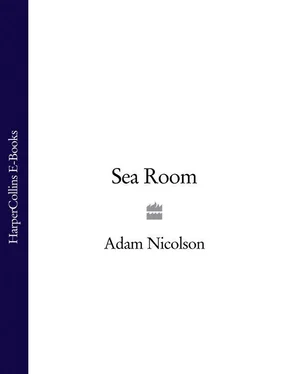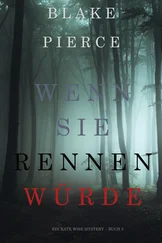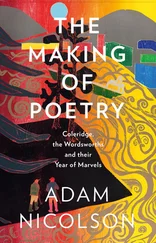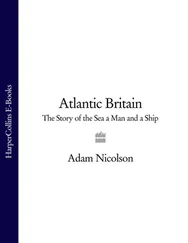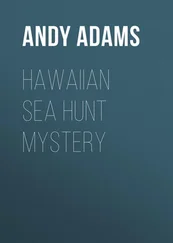The Shiants themselves, though, can never have known any of this. They never had their Hawaiian period and parakeets never flitted along these shores. These islands – or what are now these islands – came into existence two miles or so underground, perhaps under another volcano which has entirely disappeared.
That much was known in the nineteenth century. Since World War II, the understanding of the Shiant rocks has developed enormously, largely in the hands of Fergus Gibb and Mike Henderson, who, in five visits and with extensive laboratory analysis, have, quite extraordinarily to my mind, been able to establish a sequence of events that occurred here over a few decades about sixty million years ago.
It is a vast poem written in heat and liquidity. Remove the sea from your mind. That has nothing to do with it. You are in the dark of the Earth’s crust, several miles down. About a hundred and twenty million years before, in the Lower Jurassic, enormously thick accumulations of mud, silt and sand had built up in layer after layer on the floor of an earlier sea. These mud stones and shales have become rock. Beneath them, a huge bubble of hot molten rock starts to rise. The pressure it exerts opens fissures and ruptures in the overlying layers and it is between those laminations that the magma wants to squeeze.
This is the moment of the Shiants’ creation. The liquid rock, deep underground, probably took the form of what geologists call ‘a cedar tree laccolith’, a set of leaf-like chambers arranged around a central stem like the boughs of a cedar tree. The magma, pulsing from below, still hot from the energy generated when the planet first formed, runs into each chamber and beyond it into new leaves, new extensions of the form. The idea of a single tree is wrong: more likely a forest of them, the forms connected through the bough tips or a branching of the stem. The growth of this red-hot forest, each tree fifteen miles high and its canopy spreading as much as ten or fifteen miles wide, was moving north from the southern Hebrides. The whole floor of the Little Minch is covered in the leaves of that infernal cedar grove. In the far more recent past, glaciers have gouged hollows between them in the softer Jurassic sediments, leaving a family of submarine Shiants between here and Tiree. Occasionally they break surface, in the islands of Staffin Bay, the Ascrib Islands, Fladda-chuain, Eilean Trodday, all off the northern tip of Skye and in Sgeir Inoe, the lonely and vicious rock off Scalpay. Most are unseen, apparent only in the kicking of the tide.
Deep inside those ancient layers, the Shiants came into being in an orgasm of incandescent liquid. It was enormously hot: the greatest heat reached in the most violent fire in a burning building is about 850°C. That can melt bricks, turning them into pools of liquid glass. The Jurassic mudstones melt at about 900° but the heat of the magma itself was about 1150°C.
The Shiant intrusion would have been pulsed, the impulse coming and going, like a breath, an exhalation, pushing at the rocks above it and distending them. That dynamism is now fixed in the form of the rocks. You can find precisely the point – it is revealed on the shore in the bay next to the house – where the inrush of radiant magma came up against the cold mudstones in the roof of the cavity. Pull away the kelp and the serrated wrack. The little green crabs scuttle for the dark, the tiny transparent shrimps wriggle like rugby players in a tackle, and you can see the instant of creation frozen and preserved in front of you. The raging heat of the magma meets the old, cold mudstone and that meeting has had a double effect.
Elsewhere on the islands, you can see in the mudstones the layering of the sediments as they had settled onto the Jurassic sea-bed and you can find many fossils of ammonites and belemnites embedded in them like meat in a cold pie. Here, though, that has all been lost in the cataclysm. The mud stones have been baked hard into the solid grey stone called hornfels, without layers in it and without fossils. If you break the stone open, though, as Mike Henderson showed me, you can find the ghosts of the life once preserved here. Heat and pressure has transformed everything that was once in them and a faint, coppery, gilded sheen coats the inner surfaces of the rock. These are what Mike Henderson called ‘the pyritised remains’, the only evidence of the fossils which the rock once held, reduced in the furnace to this undiagnosable inkling, a breath of a suggestion, like the ash of an abandoned hearth. But the mud stones also exacted their price from the magma. Where the hot, molten intrusion came into contact with the country rock it was suddenly chilled. The semi-crystalline mush of the liquid, a kind of hot granita, was shocked into solidity by the old, cold stones. In suddenly becoming solid, the minerals in the magma are small, almost instantly formed and so the rock is as smooth and as fine-grained as cheese. That analogy is curiously exact: where you have broken the rock open, the fracture marks are exactly like those you find on the open face of a piece of broken Parmesan. ‘Chill’ or ‘chilled margin’, as this frozen magma is called, sits all alongside the hornfels on the beach, the twin products of intense heat meeting ancient cold, fifty-eight and a half million years ago.
Many things are still not clear about the making of these islands, nor is the precise order of events certain. Broadly though, it seems that several blades or ‘sills’ of magma were intruded here over a period of perhaps a century or two. One fairly narrow one, having cooled quite quickly, can be seen in the Galtas. Another makes the rib of rock through which the natural arch passes at the north-east corner of Garbh Eilean. A third forms Eilean Mhuire and the fourth, by far the largest, 537 ft. thick, created the vast bulk, about four hundred acres, of Garbh Eilean and Eilean an Tighe. No one has yet found how these sills are related to each other, nor how they are connected to the huge feeder pipe along which the magma arrived from the south, but it is obvious that some of the old Jurassic rocks, the mudstones and shales, were caught up in the process. Most of the top of Eilean Mhuire consists of a huge raft of those older rocks buoyed up like a baulk of wood on the flood of magma which poured in, mostly below but some also above it. Another slab of old rock crosses the north-east corner of Garbh Eilean and has been eroded in the bay that stretches out below the puffin slopes there. Those soft and crumbly rocks, full of the nutritious minerals which accumulated on the Jurassic sea-bed, make far better soils than the hard, solidified magma of the sills. These Jurassic rocks, richer than almost anything in Pairc or Harris, and comparable in Lewis only to equivalent rocks around Stornoway, have been the basis for most of the farming on the Shiants. Without the wealth of Eilean Mhuire and the beautiful meadows at the Bagh on Garbh Eilean, it is difficult to think that life on the Shiants would ever have been possible.
For the professional geologists, this story is only the introduction to the book. They seek to penetrate much further into the arcana of chemical detail, above all into the diagnostic mineralogy of the different sorts of rocks to be found on the islands.
Previously it had been thought that the different minerals that can be seen in different places were the result of large crystals settling towards the bottom of the sill as the magma cooled. That was the old orthodoxy developed in the 1930s but Fergus Gibb and Mike Henderson have over the last four decades pushed most of that aside and discovered a quite different process.
As they have revealed, the enormous main sill of Garbh Eilean and Eilean an Tighe is itself made up of at least four different pulses of magma. These were not violent events but of great scale and immense power, slowly applied; a slow squeezing apart of an abscess the size of fifty city blocks. The Shiants laid on Manhattan would stretch from Wall Street to Times Square. These successive pulses are not, as you might think, laid one on top of another, in the way you would assemble a sandwich: mustard on top of the ham on top of the cheese on top of the butter on top of the bread. Not at all: each new one inserted itself, in a hot, licking tongue of new magma, within the body of those that had come before. They could only have done that if the preceding magma was still quite soft. In other words, here in this main sill, they must have followed, one from the other, quite quickly. The picture is of a gradually fattening sandwich, made in something like a piece of pitta bread. You begin with the bread alone, and one by one, butter, jam and peanut butter are squeezed inside it. The sequence you end up with, then, is: bread, butter, jam, peanut butter, jam, butter, bread.
Читать дальше
